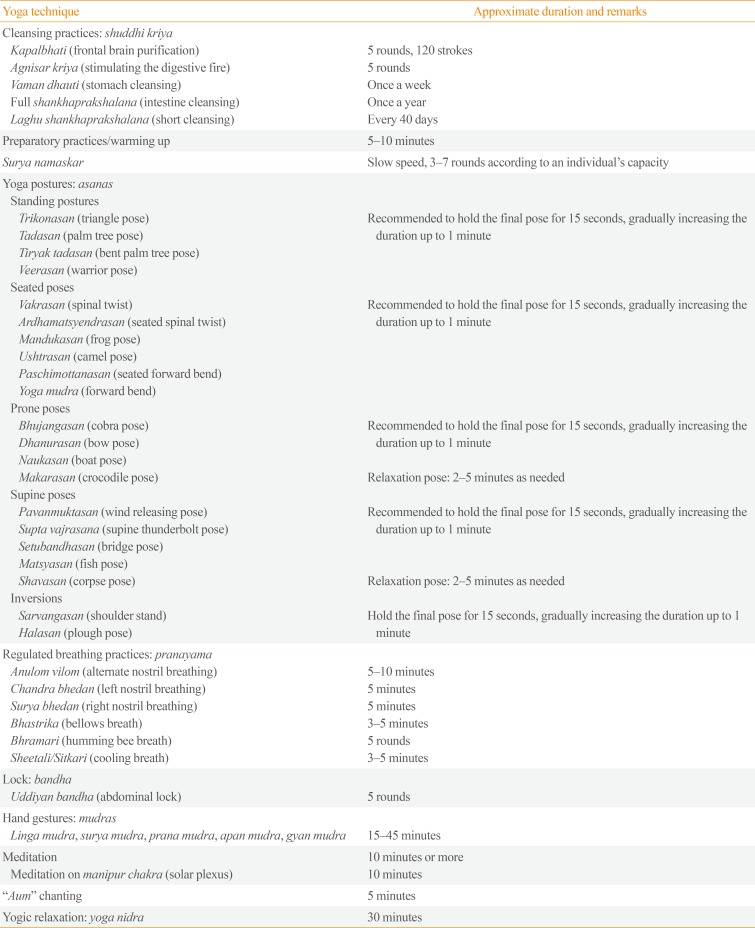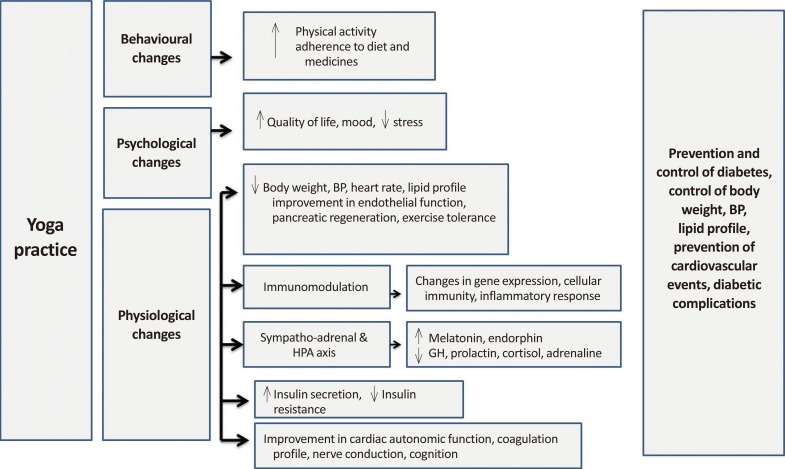1. International Diabetes Federation. Chapter 3, The global picture. IDF Diabetes Atlas. 8th ed. Brussels: International Diabetes Federation;2017. p. 40–59.
2. Thangasami SR, Chandani AL, Thangasami S. Emphasis of yoga in the management of diabetes. J Diabetes Metab. 2015; 6:613.

3. Liu XC, Pan L, Hu Q, Dong WP, Yan JH, Dong L. Effects of yoga training in patients with chronic obstructive pulmonary disease: a systematic review and meta-analysis. J Thorac Dis. 2014; 6:795–802. PMID:
24977005.
4. Jyotsna VP. Prediabetes and type 2 diabetes mellitus: evidence for effect of yoga. Indian J Endocrinol Metab. 2014; 18:745–749. PMID:
25364666.

5. Youngwanichsetha S, Phumdoung S, Ingkathawornwong T. The effects of mindfulness eating and yoga exercise on blood sugar levels of pregnant women with gestational diabetes mellitus. Appl Nurs Res. 2014; 27:227–230. PMID:
24629718.

6. Miller CK, Kristeller JL, Headings A, Nagaraja H, Miser WF. Comparative effectiveness of a mindful eating intervention to a diabetes self-management intervention among adults with type 2 diabetes: a pilot study. J Acad Nutr Diet. 2012; 112:1835–1842. PMID:
23102183.

7. Jindal N, Joshi NP. Comparative study of Vamana and Virechanakarma in controlling blood sugar levels in diabetes mellitus. Ayu. 2013; 34:263–269. PMID:
24501520.

8. Shalinee , Mishra D, Kamal K, Gupta AK, Sharma KK. Shankhaprakshalana: a yogic karma for purification. Int J Ayurvedic Herb Med. 2012; 2:578–581.
9. Skoro-Kondza L, Tai SS, Gadelrab R, Drincevic D, Greenhalgh T. Community based yoga classes for type 2 diabetes: an exploratory randomised controlled trial. BMC Health Serv Res. 2009; 9:33. PMID:
19228402.

10. Sreedevi A, Gopalakrishnan UA, Karimassery Ramaiyer S, Kamalamma L. A randomized controlled trial of the effect of yoga and peer support on glycaemic outcomes in women with type 2 diabetes mellitus: a feasibility study. BMC Complement Altern Med. 2017; 17:100. PMID:
28173786.

11. Malhotra V, Singh S, Tandon OP, Sharma SB. The beneficial effect of yoga in diabetes. Nepal Med Coll J. 2005; 7:145–147. PMID:
16519085.
12. Madhavi S, Raju PS, Reddy MV, Annapurna N, Sahay BK, Kumari DG, et al. Effect of yogic exercises on lean body mass. J Assoc Physicians India. 1985; 33:465–466. PMID:
4055664.
13. Manjunatha S, Vempati RP, Ghosh D, Bijlani RL. An investigation into the acute and long-term effects of selected yogic postures on fasting and postprandial glycemia and insulinemia in healthy young subjects. Indian J Physiol Pharmacol. 2005; 49:319–324. PMID:
16440850.
14. Mullur RS, Ames D. Impact of a 10 minute seated yoga practice in the management of diabetes. J Yoga Phys Ther. 2016; 6:1000224. PMID:
27774351.

15. Pal GK. Effects of pranayama on cardiovascular health. Int J Clin Exp Physiol. 2016; 3:57–58.

16. Bal BS. Effects of short term practice of Anuloma Viloma Pranayama on components of health-related fitness. Educ Prac Innov. 2015; 2:10–18.

17. Srivastava S, Goyal P, Tiwari SK, Patel AK. Interventional effect of Bhramari Pranayama on mental health among college students. Int J Ind Psychol. 2017; 4:29–33.

18. Nivethitha L, Mooventhan A, Manjunath NK. Effects of various PraXMLLink_XYZayama on cardiovascular and autonomic variables. Anc Sci Life. 2016; 36:72–77. PMID:
28446827.
19. Singh RB, Wilczynska-Kwiatek A, Fedacko J, Pella D, De Meester F. Pranayama: the power of breath. Int J Disabil Hum Dev. 2009; 8:141–153.

20. Gurjar AA, Ladhake SA, Thakare AP. Analysis of acoustic of “OM” chant to study it's effect on nervous system. Int J Comput Sci Netw Secur. 2009; 9:363–367.
21. Bhavanani AB, Madanmohan , Sanjay Z, Vithiyalakshmi SL. Immediate cardiovascular effects of pranava relaxation in patients with hypertension and diabetes. Biomed Hum Kinet. 2012; 4:66–69.

22. Mohanty S, Metri K, Nagaratna R, Nagendra HR. Immediate effect of mind sound resonance technique (MSRT-A yogic relaxation technique) on cognitive functions in type 2 diabetes. Voice Res. 2015; 4:44–45.
23. Jyotsna VP, Joshi A, Ambekar S, Kumar N, Dhawan A, Sreenivas V. Comprehensive yogic breathing program improves quality of life in patients with diabetes. Indian J Endocrinol Metab. 2012; 16:423–428. PMID:
22629512.

24. Ricard M, Lutz A, Davidson RJ. Mind of the meditator. Sci Am. 2014; 311:38–45.

25. Chung SC, Brooks MM, Rai M, Balk JL, Rai S. Effect of Sahaja yoga meditation on quality of life, anxiety, and blood pressure control. J Altern Complement Med. 2012; 18:589–596. PMID:
22784346.
26. Keyworth C, Knopp J, Roughley K, Dickens C, Bold S, Coventry P. A mixed-methods pilot study of the acceptability and effectiveness of a brief meditation and mindfulness intervention for people with diabetes and coronary heart disease. Behav Med. 2014; 40:53–64. PMID:
24754440.

27. Amita S, Prabhakar S, Manoj I, Harminder S, Pavan T. Effect of yoga-nidra on blood glucose level in diabetic patients. Indian J Physiol Pharmacol. 2009; 53:97–101. PMID:
19810584.
28. Singh K. Hasta Mudra's and respiratory system. Int J Phys Educ Sports Health. 2015; 1:83–86.
29. Vaishali K, Kumar KV, Adhikari P, UnniKrishnan B. Effects of yoga-based program on glycosylated hemoglobin level serum lipid profile in community dwelling elderly subjects with chronic type 2 diabetes mellitus: a randomized controlled trial. Phys Occup Ther Geriatr. 2012; 30:22–30.
30. Habibi N, Farsani ZH, Yazdani B, Arianshakib R, Noruozi P. The influence of yoga-on risk profiles programs in women with diabetes type II. Adv Environ Biol. 2013; 2013:550–556.
31. Subramaniyan TG, Subramaniyan N, Chidambaram M. Brisk walking and yoga as adjuvant therapy in management of type 2 diabetes mellitus. Int J Student Res. 2012; 2:43–46.

32. Angadi P, Jagannathan A, Thulasi A, Kumar V, Umamaheshwar K, Raghuram N. Adherence to yoga and its resultant effects on blood glucose in type 2 diabetes: a community-based follow-up study. Int J Yoga. 2017; 10:29–36. PMID:
28149065.

33. Shah NJ, Shah UN. Central retinal vein occlusion following Sirsasana (headstand posture). Indian J Ophthalmol. 2009; 57:69–70. PMID:
19075418.

34. Innes KE, Vincent HK. The influence of yoga-based programs on risk profiles in adults with type 2 diabetes mellitus: a systematic review. Evid Based Complement Alternat Med. 2007; 4:469–486. PMID:
18227915.

35. Aswathy S, Unnikrishnan AG, Kalra S. Effective management of type 2 DM in India: looking at low-cost adjunctive therapy. Indian J Endocrinol Metab. 2013; 17:149–152. PMID:
23776869.

36. Bystritsky A, Danial J, Kronemyer D. Interactions between diabetes and anxiety and depression: implications for treatment. Endocrinol Metab Clin North Am. 2014; 43:269–283. PMID:
24582102.
37. Mahajan AS. Role of yoga in hormonal homeostasis. Int J Clin Exp Physiol. 2014; 1:173–178.

38. Innes KE, Bourguignon C, Taylor AG. Risk indices associated with the insulin resistance syndrome, cardiovascular disease, and possible protection with yoga: a systematic review. J Am Board Fam Pract. 2005; 18:491–519. PMID:
16322413.

39. Kosuri M, Sridhar GR. Yoga practice in diabetes improves physical and psychological outcomes. Metab Syndr Relat Disord. 2009; 7:515–517. PMID:
19900155.

40. Brown RP, Gerbarg PL. Sudarshan Kriya yogic breathing in the treatment of stress, anxiety, and depression. Part II: clinical applications and guidelines. J Altern Complement Med. 2005; 11:711–717. PMID:
16131297.
41. Gangadhar BN, Naveen GH, Rao MG, Thirthalli J, Varambally S. Positive antidepressant effects of generic yoga in depressive out-patients: a comparative study. Indian J Psychiatry. 2013; 55(Suppl 3):S369–S373. PMID:
24049201.

42. Agrawal RP, Aradhana SH, Beniwal R, Sabir M, Kochar DK. Influence of yogic treatment on quality of life outcomes, glycaemic control and risk factors in diabetes mellitus. Int J Diab Dev Countries. 2003; 23:130–134.
43. Ross A, Thomas S. The health benefits of yoga and exercise: a review of comparison studies. J Altern Complement Med. 2010; 16:3–12. PMID:
20105062.

44. Kiecolt-Glaser JK, Christian LM, Andridge R, Hwang BS, Malarkey WB, Belury MA, et al. Adiponectin, leptin, and yoga practice. Physiol Behav. 2012; 107:809–813. PMID:
22306535.

45. Newberg AB, Iversen J. The neural basis of the complex mental task of meditation: neurotransmitter and neurochemical considerations. Med Hypotheses. 2003; 61:282–291. PMID:
12888320.

46. Shree N, Bhonde RR. Can yoga therapy stimulate stem cell trafficking from bone marrow? J Ayurveda Integr Med. 2016; 7:181–184. PMID:
27649634.

47. Dusek JA, Otu HH, Wohlhueter AL, Bhasin M, Zerbini LF, Joseph MG, et al. Genomic counter-stress changes induced by the relaxation response. PLoS One. 2008; 3:e2576. PMID:
18596974.

48. Hegde SV, Adhikari P, Kotian S, Pinto VJ, D'Souza S, D'Souza V. Effect of 3-month yoga on oxidative stress in type 2 diabetes with or without complications: a controlled clinical trial. Diabetes Care. 2011; 34:2208–2210. PMID:
21836105.
49. Gordon L, Morrison EY, McGrowder D, Penas YF, Zamoraz EM, Garwood D, et al. Effect of yoga and traditional physical exercise on hormones and percentage insulin binding receptor in patients with type 2 diabetes. Am J Biochem Biotechnol. 2008; 4:35–42.

50. Sahay BK. Yoga and diabetes. J Assoc Physicians India. 1986; 34:645–648. PMID:
3793701.
51. Bhaskaracharyulu C, Raju PS, Madhavi S. The effect of yoga on lipoprotein profile in diabetics. J Diabet Assoc India. 1986; XXVI:120–122.
52. Sahay BK. Role of yoga in diabetes. J Assoc Physicians India. 2007; 55:121–126. PMID:
17571741.
53. Kapur A. Proceedings of novo nordisk diabetes update. Yoga and diabetes. Bombay: Health Care Communications;1994. p. 159–167.
54. McDermott KA, Rao MR, Nagarathna R, Murphy EJ, Burke A, Nagendra RH, et al. A yoga intervention for type 2 diabetes risk reduction: a pilot randomized controlled trial. BMC Complement Altern Med. 2014; 14:212. PMID:
24980650.

55. Vaibhavi B, Satyam T, Sanjibkumar P, Raghuram N, Ramarao NH. Effect of holistic module of yoga and Ayurvedic Panchakarma in type 2 diabetes mellitus: a pilot study. Open J Endocr Metab Dis. 2013; 3:90–98.
56. Cui J, Yan JH, Yan LM, Pan L, Le JJ, Guo YZ. Effects of yoga in adults with type 2 diabetes mellitus: a meta-analysis. J Diabetes Investig. 2017; 8:201–209.

57. Sahay BK, Murthy KJR, Raju PS, Madhavi S. Effect of yogic practices on exercises tolerance in diabetes. Diabetes. 1991; 40(Suppl 1):398.
58. Hagins M, States R, Selfe T, Innes K. Effectiveness of yoga for hypertension: systematic review and meta-analysis. Evid Based Complement Alternat Med. 2013; 2013:649836. PMID:
23781266.

59. Cramer H, Lauche R, Haller H, Steckhan N, Michalsen A, Dobos G. Effects of yoga on cardiovascular disease risk factors: a systematic review and meta-analysis. Int J Cardiol. 2014; 173:170–183. PMID:
24636547.

60. Chohan IS, Nayar HS, Thomas P, Geetha NS. Influence of yoga on blood coagulation. Thromb Haemost. 1984; 51:196–197. PMID:
6740553.

61. Patwardhan AR. Yoga research and public health: is research aligned with the stakeholders' needs? J Prim Care Community Health. 2016; 8. 11. [Epub]. DOI:
10.1177/2150131916664682.






 PDF
PDF ePub
ePub Citation
Citation Print
Print




 XML Download
XML Download